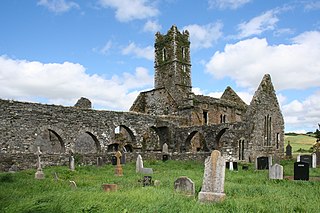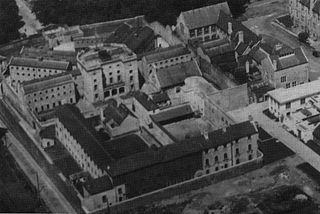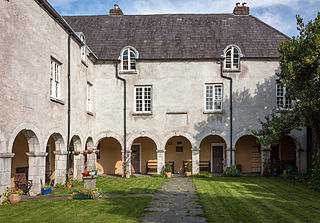
Dublin Castle is a former motte-and-bailey castle and current Irish government complex and conference centre. It was chosen for its position at the highest point of central Dublin.

Cork Institute of Technology was an institute of technology, located in Cork, Ireland. Upon its dissolution, the institute had 17,000 students studying in art, business, engineering, music, drama and science disciplines. The institute had been named as Institute of Technology of the Year in The Sunday Times University Guide for Ireland on numerous occasions. On 1 January 2021, the institute merged with the Institute of Technology, Tralee to become the Munster Technological University, Ireland's second technological university.

Crosshaven is a village in County Cork, Ireland. It is located in lower Cork Harbour at the mouth of the River Owenabue, across from Currabinny Wood. Originally a fishing village, from the 19th century, the economy of the area became more reliant on a growing tourism industry.
The architecture of Ireland is one of the most visible features in the Irish countryside – with remains from all eras since the Stone Age abounding. Ireland is famous for its ruined and intact Norman and Anglo-Irish castles, small whitewashed thatched cottages and Georgian urban buildings. What are unaccountably somewhat less famous are the still complete Palladian and Rococo country houses which can be favourably compared to anything similar in northern Europe, and the country's many Gothic and neo-Gothic cathedrals and buildings.

Timoleague Friary, also known as Timoleague Abbey, is a ruined medieval Franciscan friary in Timoleague, County Cork, Ireland, on the banks of the Argideen River overlooking Courtmacsherry Bay. It was built on the site of an early Christian monastic site founded by Saint Molaga, from whom the town of Timoleague derives its name. The present remains date from roughly the turn of the fourteenth century and were burnt down by British forces in the mid-seventeenth century, at which point it was an important ecclesiastical centre that engaged in significant trade with Spain.

Justin McCarthy was an Irish nationalist, journalist, historian, novelist and politician. He was a Member of Parliament (MP) from 1879 to 1900, taking his seat in the House of Commons of the United Kingdom of Great Britain and Ireland.
Thomas McCarthy is an Irish poet, novelist, and critic, born in Cappoquin, County Waterford, Ireland. He attended University College Cork where he was part of a resurgence of literary activity under the inspiration of John Montague. Among McCarthy's contemporaries, described by Thomas Dillon Redshaw as "that remarkable generation", were the writers and poets Theo Dorgan, Sean Dunne, Greg Delanty, Maurice Riordan and William Wall. McCarthy edited, at various times, The Cork Review and Poetry Ireland Review. He has published seven collections of poetry with Anvil Press Poetry, London, including The Sorrow Garden, The Lost Province, Mr Dineen's Careful Parade, The Last Geraldine Officer, and Merchant Prince. The main themes of his poetry are Southern Irish politics, love and memory. He is also the author of two novels; Without Power and Asya and Christine. He is married with two children and lives in Cork City where he worked in the City Libraries until his retirement. He won the Patrick Kavanagh Poetry Award in 1977. His monograph "Rising from the Ashes" tells the story of the burning of the Carnegie Free Library in Cork City by the Black and Tans in 1920 and the subsequent efforts to rebuild the collection with the help of donors from all over the world.

The Cathedral Quarter in Belfast, Northern Ireland, is a developing area of the city, roughly situated between Royal Avenue near where the Belfast Central Library building is, and the Dunbar Link in the city centre. From one of its corners, the junction of Royal Avenue, Donegall Street and York Street, the Cathedral Quarter lies south and east. Part of the area, centred on Talbot Street behind the cathedral, was formerly called the Half Bap. The "Little Italy" area was on the opposite side of Great Patrick Street centred on Little Patrick Street and Nelson Street.

Cork is the second largest city in the Republic of Ireland, third largest on the island of Ireland, and largest in the province of Munster. At the 2022 census, it had a population of 222,526.

Washington Street is a street in central Cork city, Ireland. Built in 1824, it runs from the old medieval town centre onto the site of the western marshes, and today links the Western Road and Lancaster Quay with the Grand Parade.

The Limerick Athenaeum was a centre of learning, established in Limerick city, Ireland, in 1852.
John Butts was an Irish landscape painter, specialising in woodland and river scenes.

Cork County Gaol was a former prison located in Cork, Ireland. The main walls and gate entrance of the prison are today incorporated in the perimeter of University College Cork.

Saints Peter and Paul's Church is a Catholic church located on Carey's Lane in Cork City, Ireland.

Skiddy's Almshouse is the oldest inhabited building in the city of Cork. It was built in 1718 and finished in 1719.
The 2017 FAI Cup Final was the final match of the 2017 FAI Cup, the national association football cup of the Republic of Ireland. The match took place on Sunday 5 November 2017 at the Aviva Stadium in Dublin, and was contested by Cork City and Dundalk. The match was a repeat of the 2015, and 2016 finals.
Elections to the Cork Corporation took place on Thursday 15 January 1920 as part of that year's Irish local elections.

Cork Courthouse is a judicial facility in Washington Street, Cork, Ireland. It serves as the Cork Court Office in civil and family related matters, while the courthouse on Anglesea Street handles criminal trials. It operates on the level of both the District and Circuit Courts. The courthouse occupies the entire block between Washington Street, Liberty Street, Cross Street and Courthouse Street.

Castlefreke, also known as Rathbarry, is a townland and village in County Cork, Ireland. The townland is located in the civil parish of Rathbarry on the R598 regional road, to the east of Rosscarbery.

The Firkin Crane is a non-profit arts organisation based in the protected building of the same name in the Shandon area of Cork City in Ireland. It is a theatre and dance centre and is a permanent base for Cork City Ballet and Crux Dance Theatre.















